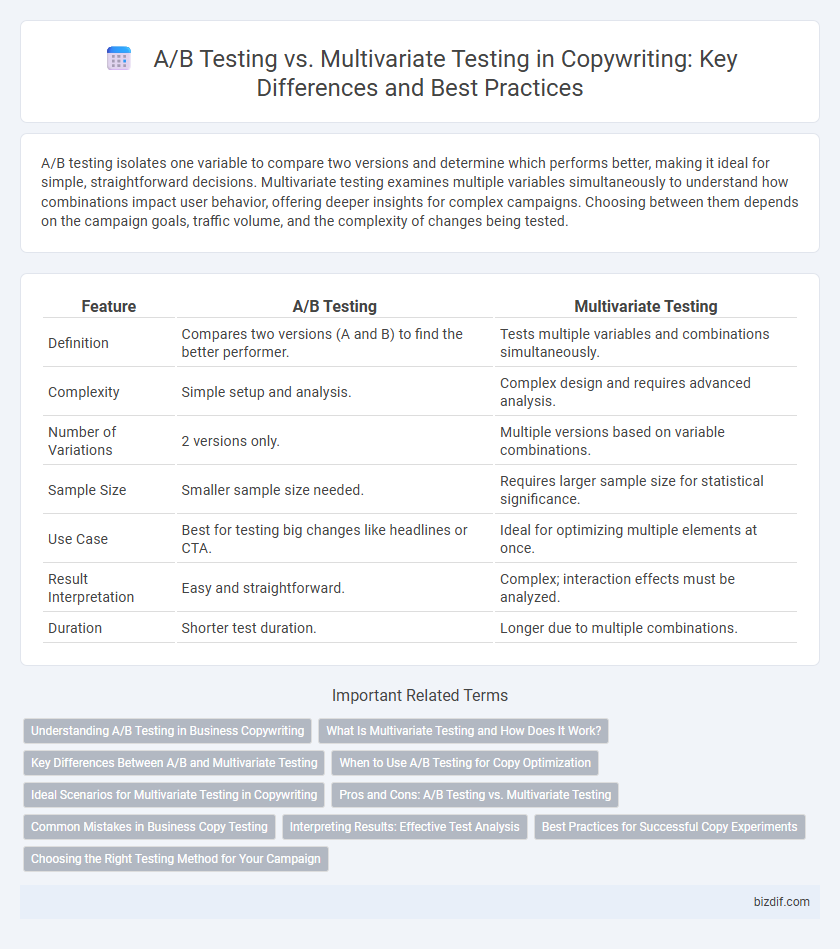A/B testing isolates one variable to compare two versions and determine which performs better, making it ideal for simple, straightforward decisions. Multivariate testing examines multiple variables simultaneously to understand how combinations impact user behavior, offering deeper insights for complex campaigns. Choosing between them depends on the campaign goals, traffic volume, and the complexity of changes being tested.
Table of Comparison
| Feature | A/B Testing | Multivariate Testing |
|---|---|---|
| Definition | Compares two versions (A and B) to find the better performer. | Tests multiple variables and combinations simultaneously. |
| Complexity | Simple setup and analysis. | Complex design and requires advanced analysis. |
| Number of Variations | 2 versions only. | Multiple versions based on variable combinations. |
| Sample Size | Smaller sample size needed. | Requires larger sample size for statistical significance. |
| Use Case | Best for testing big changes like headlines or CTA. | Ideal for optimizing multiple elements at once. |
| Result Interpretation | Easy and straightforward. | Complex; interaction effects must be analyzed. |
| Duration | Shorter test duration. | Longer due to multiple combinations. |
Understanding A/B Testing in Business Copywriting
A/B testing in business copywriting involves comparing two versions of a single element, such as headlines or call-to-action buttons, to determine which one drives higher engagement or conversions. This method isolates variables, making it easier to attribute changes in user behavior directly to specific copy elements. By leveraging A/B testing, businesses can optimize messaging effectiveness and improve return on investment in marketing campaigns.
What Is Multivariate Testing and How Does It Work?
Multivariate testing analyzes multiple variables simultaneously to determine the most effective combination of elements within a webpage or ad. It works by creating variations of different components, such as headlines, images, and call-to-action buttons, then measuring user interactions to identify the optimal combination for conversion. This method provides deeper insights into how elements interact together, enabling more precise copywriting optimization than traditional A/B testing.
Key Differences Between A/B and Multivariate Testing
A/B testing compares two versions of a single variable to identify which one performs better, while multivariate testing evaluates multiple variables and their combinations simultaneously to understand complex interactions. A/B testing is simpler and faster, ideal for testing headline or CTA changes, whereas multivariate testing requires more traffic and sophisticated analysis to determine the optimal mix of elements. Key differences include scope, complexity, and data requirements, with A/B testing focusing on isolated changes and multivariate testing analyzing variable interdependencies.
When to Use A/B Testing for Copy Optimization
A/B testing is ideal for comparing two distinct versions of copy to identify which one drives higher conversion rates, making it perfect for clear, singular changes such as headline or call-to-action variations. It works best when testing specific hypotheses about key copy elements without the complexity of multiple variables influencing the outcome. Use A/B testing for quick, focused optimization that provides statistically significant results with relatively low traffic requirements.
Ideal Scenarios for Multivariate Testing in Copywriting
Multivariate testing is ideal in copywriting when multiple elements such as headlines, call-to-action buttons, and images need simultaneous optimization to determine the best-performing combination. This method excels in complex scenarios where interactions between various copy elements significantly impact conversion rates and user engagement. Marketers benefit from multivariate testing when seeking granular insights into how different text variations synergize to enhance message clarity and persuasive power.
Pros and Cons: A/B Testing vs. Multivariate Testing
A/B testing offers simplicity and clear insights by comparing two variations to identify which performs better, making it ideal for testing single element changes but can be time-consuming for complex scenarios. Multivariate testing evaluates multiple variables simultaneously, enabling the analysis of interactions between elements and faster optimization of overall design, though it requires larger sample sizes and can be more challenging to interpret. Choosing between A/B and multivariate testing depends on campaign goals, traffic volume, and the complexity of changes being tested.
Common Mistakes in Business Copy Testing
Businesses often confuse A/B testing with multivariate testing, leading to incomplete or misleading results due to improper sample size and test duration. Common mistakes include testing too many variables simultaneously in A/B testing, which reduces statistical power, and failing to isolate variable interactions in multivariate testing. Misinterpreting data without considering conversion goals or user segmentation can skew insights and impede effective copy optimization.
Interpreting Results: Effective Test Analysis
Interpreting results in A/B testing involves comparing two versions to identify which copy variation directly impacts conversion rates, simplifying decision-making with clear, actionable insights. Multivariate testing analyzes multiple variables simultaneously to determine how different headline, image, and call-to-action combinations interact, providing a deeper understanding of copy element effectiveness. Effective test analysis uses statistical significance and performance metrics to ensure reliable conclusions and optimize copywriting strategies for maximum engagement.
Best Practices for Successful Copy Experiments
Implement clear hypotheses and measure specific conversion metrics when conducting A/B testing or multivariate testing to optimize copywriting effectiveness. Segment audiences precisely to isolate variables such as headlines, CTAs, and value propositions, ensuring statistically significant results. Maintain consistent test durations and control environmental factors to accurately assess the impact of copy variations on user engagement and conversion rates.
Choosing the Right Testing Method for Your Campaign
Choosing the right testing method depends on your campaign goals and complexity; A/B testing is ideal for comparing two versions of a single variable to optimize headlines, CTAs, or visuals, driving straightforward performance insights. Multivariate testing analyzes multiple variables simultaneously to identify the best combination, suitable for mature campaigns with sufficient traffic to provide statistically significant results. Evaluating traffic volume, resource availability, and the specificity of hypotheses ensures selecting the appropriate approach for maximizing conversion rates and ROI.
A/B Testing vs Multivariate Testing Infographic

 bizdif.com
bizdif.com